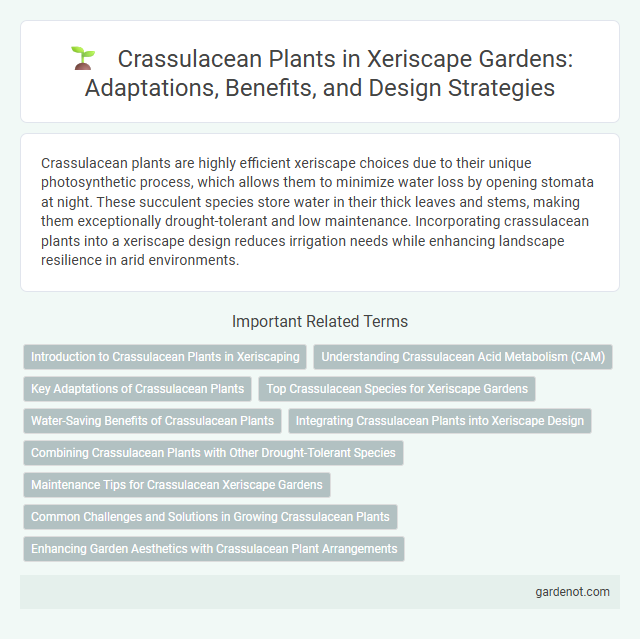Crassulacean plants are highly efficient xeriscape choices due to their unique photosynthetic process, which allows them to minimize water loss by opening stomata at night. These succulent species store water in their thick leaves and stems, making them exceptionally drought-tolerant and low maintenance. Incorporating crassulacean plants into a xeriscape design reduces irrigation needs while enhancing landscape resilience in arid environments.
Introduction to Crassulacean Plants in Xeriscaping
Crassulacean plants, including succulents like jade and sedum, are ideal for xeriscaping due to their specialized water-conserving metabolism known as CAM (Crassulacean Acid Metabolism). These plants open their stomata at night to minimize water loss while efficiently storing carbon dioxide for photosynthesis during the day. Their drought-resistant qualities and low maintenance requirements make Crassulacean plants essential for sustainable, water-efficient landscaping in arid and semi-arid regions.
Understanding Crassulacean Acid Metabolism (CAM)
Crassulacean Acid Metabolism (CAM) is a specialized photosynthetic adaptation found in Crassulacean plants that enhances water-use efficiency by opening stomata at night to fix CO2, reducing daytime water loss. This process involves the temporal separation of carbon fixation and the Calvin cycle, storing CO2 as malic acid in vacuoles during nighttime and releasing it for photosynthesis during daylight. CAM allows xeriscape landscapes to thrive in arid environments by minimizing transpiration and optimizing water conservation.
Key Adaptations of Crassulacean Plants
Crassulacean plants exhibit key adaptations such as CAM photosynthesis, which allows them to open stomata at night to minimize water loss while fixing CO2. Their succulent leaves store water efficiently, enabling survival in arid environments with sporadic rainfall. Thick cuticles and reduced leaf surface areas further reduce transpiration, enhancing drought tolerance in xeriscape landscapes.
Top Crassulacean Species for Xeriscape Gardens
Crassulacean Acid Metabolism (CAM) plants such as Sedum, Echeveria, and Kalanchoe are ideal for xeriscape gardens due to their exceptional drought tolerance and efficient water use. Sedum spp., known for their succulent leaves and vibrant flowers, thrive in low-water environments and poor soils, making them perfect ground covers. Echeveria and Kalanchoe species excel in xeriscaping with their rosette shapes and ability to store water, reducing irrigation needs dramatically.
Water-Saving Benefits of Crassulacean Plants
Crassulacean Acid Metabolism (CAM) plants exhibit exceptional water-saving benefits by opening their stomata at night to minimize water loss during transpiration. This efficient water-use adaptation allows CAM plants, such as jade and sedum, to thrive in xeriscape landscapes with minimal irrigation requirements. Their ability to store carbon dioxide as malic acid during cooler nighttime hours makes them ideal for water conservation in drought-prone environments.
Integrating Crassulacean Plants into Xeriscape Design
Integrating Crassulacean plants such as Sedum and Echeveria into xeriscape design enhances water efficiency by leveraging their unique CAM photosynthesis, which conserves moisture during arid conditions. These succulents thrive in well-drained soils and require minimal irrigation, making them ideal for sustainable landscapes in drought-prone regions. Strategic placement of Crassulacean plants can reduce water consumption while adding diverse textures and vibrant colors to xeriscape gardens.
Combining Crassulacean Plants with Other Drought-Tolerant Species
Combining Crassulacean Acid Metabolism (CAM) plants such as succulents and agaves with other drought-tolerant species like lavender and yucca enhances water conservation and soil stability in xeriscape landscapes. CAM plants optimize nighttime CO2 absorption, reducing daytime water loss, while drought-resistant companions provide complementary textures and prolonged bloom periods. Integrating these species promotes a resilient, low-maintenance garden designed for arid environments, minimizing irrigation needs and maximizing ecological sustainability.
Maintenance Tips for Crassulacean Xeriscape Gardens
Crassulacean plants in xeriscape gardens thrive with minimal water, making them ideal for drought-resistant landscaping. Regularly check soil moisture to avoid overwatering, as these plants store water in their leaves and prefer well-drained soil. Prune dead or damaged leaves to promote healthy growth and prevent pests, while using organic mulch to retain soil moisture and suppress weeds.
Common Challenges and Solutions in Growing Crassulacean Plants
Crassulacean plants often face challenges such as overwatering, poor drainage, and insufficient light, which can lead to root rot and leggy growth. Ensuring well-draining soil and providing bright, indirect sunlight helps prevent these issues, while watering sparingly and only when the soil is dry supports healthy development. Using mulch and grouping similar drought-tolerant plants can also improve moisture retention and air circulation, promoting robust growth in xeriscape gardens.
Enhancing Garden Aesthetics with Crassulacean Plant Arrangements
Crassulacean plants, known for their succulent leaves and unique water-storing capabilities, offer exceptional drought resistance ideal for xeriscape gardens. Arranging these plants in varied textures and colors enhances visual interest and creates focal points while minimizing water usage. Their ability to thrive in arid conditions ensures sustainable beauty and low maintenance in any dry climate landscape.
Crassulacean plant Infographic

 gardenot.com
gardenot.com